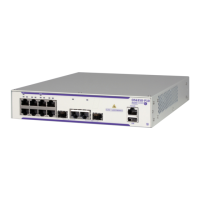SNMP Commands
OmniSwitch 6250 CLI Reference Guide November 2009 page 10-3
snmp station
Adds a new SNMP station; modifies or deletes an existing SNMP station.
snmp station {ip_address | ipv6_address} {[udp_port] [username] [v1 | v2 | v3] [enable | disable]}
no snmp station {ip_address | ipv6_address}
Syntax Definitions
ip_address The IP address to which SNMP unicast traps will be sent.
ipv6_address The IPv6 address to which SNMP unicast traps will be sent.
udp_port A UDP destination port.
username The user name on the switch or external server used to send traps to the
SNMP station(s).
The username specified here must match an
existing user account name.
v1 Specifies that traps are sent using SNMP version 1.
v2 Specifies that traps are sent using SNMP version 2.
v3 Specifies that traps are sent using SNMP version 3.
enable Enables the specified SNMP station.
disable Disables the specified SNMP station.
Defaults
Platforms Supported
OmniSwitch 6250
Usage Guidelines
• Use the no form of the command to remove an existing SNMP station.
• When adding an SNMP station, you must specify an IP address plus username parameters. For exam-
ple, the syntax snmp station 1.2.3.4 is not a valid command entry; however, snmp station 1.2.3.4
username1 is a valid command entry.
• You can establish up to 50 SNMP sessions towards an OmniSwitch.
• When modifying an SNMP station, you must specify an IP address plus at least one additional
parameter. For example, the syntax snmp station 1.2.3.4 is not a valid command entry; however,
snmp station 1.2.3.4 v2 is a valid command entry.
parameter default
udp_port 162
v1 | v2 | v3 v3
enable | disable enable

